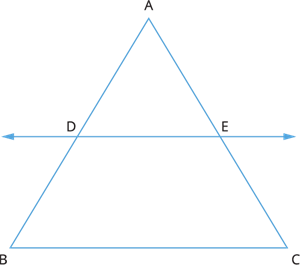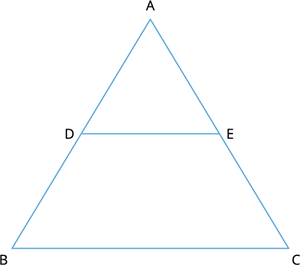UPSKILL MATH PLUS
Learn Mathematics through our AI based learning portal with the support of our Academic Experts!
Learn moreLet us learn how to apply theorems to solve problems.
Example:
1. In a \(\triangle ABC\), a straight line \(DE\) intersects \(AB\) at \(D\) and \(AC\) at \(E\) and is parallel to \(BC\), then prove that \(\frac{AB}{AD} = \frac{AC}{AE}\)
Solution:

By Thales theorem, we have:
\(\frac{AD}{DB} = \frac{AE}{EC}\)
\(\frac{DB}{AD} = \frac{EC}{AE}\)
Adding \(1\) on both sides of the equation, we have:
\(\frac{DB}{AD} + 1 = \frac{EC}{AE} + 1\)
\(\frac{DB + AD}{AD} = \frac{EC + AE}{AE}\)
\(\frac{AB}{AD} = \frac{AC}{AE}\)
Hence, we proved.
2. In a \(\triangle ABC\), \(D\) and \(E\) are points on \(AB\) and \(AC\) respectively such that \(\frac{AD}{DB} = \frac{AE}{EC}\) and \(\angle ADE = \angle DEA\). Prove that \(\triangle ABC\) is isosceles.
Solution:

Given that \(\frac{AD}{DB} = \frac{AE}{EC}\), then by the converse of Thales theorem, we have:
\(DE \parallel BC\)
Therefore, \(\angle ADE = \angle ABC\) [Corresponding angles] ---- (\(1\))
and \(\angle DEA = \angle BCA\) [Corresponding angles] ---- (\(2\))
But, it is given that \(\angle ADE = \angle DEA\) ---- (\(3\))
Using (\(1\)) and (\(2\)) in equation (\(3\)), we get:
\(\angle ABC = \angle BCA\)
Therefore, \(AC = AB\) [If opposite angles are equal, then opposite sides are equal.]
Thus, \(\triangle ABC\) is isosceles.
Hence, we proved.